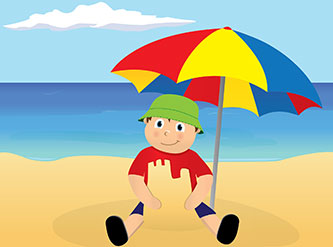Phone: 252-636-1919





Here you will find educational articles on topics relating to your family’s health. Click here for our articles archive.

One blistering sunburn during childhood more than doubles a person’s chances of developing skin cancer later in life and unprotected skin can be damaged by the sun in as little as 15 minutes. Kids don’t have to be at the pool, beach, or on vacation to be overexposed to the sun. Your child’s skin needs protection from the sun’s harmful ultraviolet (UV) rays whenever he goes outside for a period of time, and parents need to be vigilant about sun protection at all times.
Ultraviolet (UV) radiation is part of the electromagnetic light spectrum that reaches Earth from the sun. The wavelengths are shorter than visible light, making them invisible to the naked eye. There are three classifications of wavelengths: UVA, UVB, UVC. Both UVA and UVB extend to the earth, but UVC rays are mostly absorbed by the ozone layer. UVA rays account for up to 95 percent of all UV radiation reaching the Earth’s surface. UVB rays damage the skin’s outermost layer and are the rays that cause sunburn and sun poisoning. UVA penetrates the skin deeper than UVB, and plays a major part in aging, wrinkling, and skin cancer.
Below are sun safety guidelines for children 0-6 months, 6-12 months, and over one year.
Infants under 6 months should be kept out of the sun as much as possible, because their skin is too sensitive for sunscreen. Babies are extra susceptible to the sun’s damaging effects, because their skin possesses little melanin, the pigment that gives color and protection to skin. To protect infants under 6 months:
After 6 months, it is safe to begin using sunscreen on babies, but it is important to note all sunscreen products do not have the same ingredients and protection. If your child’s skin reacts badly to one brand, try another, or call one of our pediatricians to discuss the reaction. Although your baby can now wear sunscreen, avoiding the sun or seeking shade is his best defense against sunburn. Apply SPF 15+ to your child at least 30 minutes before going outdoors. Sunscreen should be applied every two hours, or after swimming or excessive sweating.
For children older than one year, follow these general steps to protect from the sun’s harmful rays. Educating your children on the sun’s harmful effects and the importance of protection is vital to creating life long sun safety habits.
Keep in mind applying sunscreen does not mean children should play in the sun all day. Combine sunscreen with hats, protective clothing, sunglasses and limit sun exposure during the peak sun times. It is also important to note that cloudy days don’t mean sunscreen can be forgotten. Clouds don’t block UV rays, only slightly filter them, so sunburn is still possible on days where the sun isn’t present. For more tips and information on sun safety, call our office at (252) 636-1919, or discuss your concerns with a CarolinaEast Pediatrics physician during your child’s next appointment.
Source:
Centers for Disease Control and Prevention
The Skin Cancer Foundation